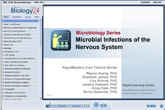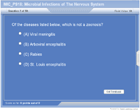| How to Learn in 24 Hours? |
|
| Need Help? |
M-F: 9am-5pm(PST):
Toll-Free: (877) RAPID-10
or 1-877-727-4310
24/7 Online Technical Support:
The Rapid Support Center
vip@rapidlearningcenter.com
Secure Online Order:

|
| Tell-A-Friend: |
Have friends taking science and math courses too? Tell them about our rapid learning system.
|
|
Nervous System Infections
| Topic Review on "Title": |
- The Central Nervous System (CNS) consists of the brain and spinal cord. The brain has three large regions called: cerebrum, cerebellum and brain stem.
- Cerebrum is responsible for the control of involuntary muscles, perception and thinking.
- Cerebellum controls involuntary movements. The CNS is an axenic environment. That means the CNS is a closed system and has no normal microbiota.
- Brain stem connects the brain to the spinal cord. It also controls breathing, heart rate and blood pressure.
Spinal Cord:
- 7 cervical vertebrae
- 12 thoracic vertebrae
- 3 lumbar vertebrae
- Sacrum
- Coccyx
- Cauda equine are a bundle of nerves that extends from the spinal cord below the lumbar region.
Meninges
- The meninges are three layers of tissue that surround the brain and spinal cord.
- Dura mater: Lies next to the bones (e.g. skull), is a tough and fibrous sheath that is strong and flexible. It covers the soft organs of the CNS. The dura mater provides a barrier against the spread of infections from the bones.
- Arachnoid mater: going inward from the dura mater the next layer is the arachnoid mater. It has numerous branching fibers that look like a spider’s web. The area between the fibers are called subarachnoid space.
- Pia mater: the internal meninx is closest to the spinal cord and brain. The blood vessels that supply the CNS are on top of the pia mater. These blood vessel walls are made up of very tightly joined cells and collectively are called the blood-brain barrier.
Peripheral Nervous System (PNS)
- Consists of nerves that transfer messages from the CNS to the muscles and glands in the body. It also serves to provide information to the CNS about the body. Cranial nerves come from the brain through holes in the cranial bones. Spinal nerves come from the spinal cord through gaps in the vertebrae.
- There are three types of nerves (based on function): sensory, motor and mixed nerves.
- The PNS is made up of nerves and neuron that are outside the CNS and not protected by bone or the blood brain barrier. The PNS has a greater exposure to toxins and mechanical injuries. The PNS is subdivided into the somatic nervous system and the autonomic nervous system.
Structure of a Neuron
- There are two types of fingerlike projections from neurons: axons and dendrites. Many small short projections coming from the cell body are called dendrites. A single long projection is called an axon.
- An axon generates an electrical potential also called a nerve impulse. Within an axon the cytoskeleton transports substances by a process called axonal transport.
- Synapses are at the terminal ends of axons and form junctions with other neurons. The synapse is responsible for transfer of a signal to a neighboring postsynaptic cell.
- In most cases there is a space between the synapses called the synaptic cleft. The cleft stops the electrical signal from passing so the neuron releases chemicals called neurotransmitters. The neurotransmitter can pass a signal to either stimulate or inhibit.
Motor neurons
- Motor neurons forms a synapse with a muscle cell. This synapse is called a neuromuscular junction. There is a space between the neuron and the muscle cell (synaptic cleft). The motor neuron releases a neurotransmitter acetylcholine (Ach) which binds to the surface of the muscle cell and sends the signal for the muscle to contract.
- A diverse set of pathogens and toxins that exploit vulnerabilities in the nervous system are presented.
|
| Rapid Study Kit for "Title": |
| Flash Movie |
Flash Game |
Flash Card |
| Core Concept Tutorial |
Problem Solving Drill |
Review Cheat Sheet |
 |
 |
 |
|
| "Title" Tutorial Summary : |
The nervous system is composed of the central and peripheral nervous system. The CNS includes the spinal cord and brain while the peripheral nervous system includes those nerves that extend into the body and are not protected by bone. Diseases of the CNS and PNS are caused by many different types of pathogens some of these are represented by: bacteria, viruses, fungi, toxins and amoebae.
Diseases of the nervous system include meningitis or encephalitis. Meningitis is the inflammation of the meninges (tissue covering the brain and spinal cord) and under certain situations lead to killing areas of the tissue. Encephalitis has symptoms similar to meningitis but includes the infection of the brain.
|
| Tutorial Features: |
Specific Tutorial Features:
- Diagrams and animations of structural features of the nervous system.
- Description of how pathogens and toxins exploit vulnerabilities of the nervous system.
- Life Cycle diagrams of pathogens are presented.
- Flow diagram of the movement of cerebral spinal fluid.
Series Features:
- Concept map showing inter-connections of new concepts in this tutorial and those previously introduced.
- Definition slides introduce terms as they are needed.
- Visual representation of concepts
- Animated examples—of concepts are used to step wise breakdown a concepts.
- A concise summary is given at the conclusion of the tutorial.
|
| "Title" Topic List: |
Structure of the central and peripheral nervous system.
Entry points for infection of the central nervous system.
Bacterial diseases of the nervous system.
Common viral diseases affecting the nervous system.
Protozoan infections in the central nervous system.
|
See all 24 lessons in Anatomy and Physiology, including concept tutorials, problem drills and cheat sheets:
Teach Yourself Microbiology Visually in 24 Hours
|



